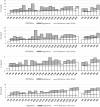The Need and Safety of Mineral Supplementation in Adults with Obesity Post Bariatric Surgery-Sleeve Gastrectomy (SG)
- PMID: 34345960
- PMCID: PMC8458182
- DOI: 10.1007/s11695-021-05639-9
The Need and Safety of Mineral Supplementation in Adults with Obesity Post Bariatric Surgery-Sleeve Gastrectomy (SG)
Abstract
Purpose: Most of the research indicated that daily dietary intake of minerals in SG patients was lower than the current recommendations. The aim of the study was to assess the need and safety of a mineral supplementation practice in adults with obesity, at 3, 6, and 9 months post bariatric surgery-sleeve gastrectomy (SG).
Methods: The study included 24 women and 6 men. Based on a 4-day food record questionnaire, mineral and calorie intake was calculated at 3, 6, and 9 months after bariatric surgery (SG). Furthermore, an interview on supplement intake was also conducted.
Results: It was found that in both men and women, there was a dietary intake deficiency of calcium (97% of respondents), potassium (97%), magnesium (83%), sodium (60%), and zinc (53%). In women, the deficiencies also included iron (50%) and copper (29%). Only 72% of the patients took dietary supplements. The applied supplementation did not adjust for the required intake of calcium in all of the patients, as well as the intake of magnesium in the male patients. Low intake of sodium and potassium were not supplemented and should be corrected by diet modification. The patients did not require supplementation of phosphorus or manganese, while male patients did not require iron or copper supplementation. The dietary and/or supplemental intake of minerals did not exceed the tolerable upper intake level (UL).
Conclusion: The results of the study confirm the need to implement personalized mineral supplementation for bariatric surgery patients.
Keywords: Adults; Mineral intake; Mineral supplementation; Sleeve gastrectomy (SG).
© 2021. The Author(s).
Conflict of interest statement
The authors declare no competing interests.
Figures


Comment in
-
Would Metabolic Rate Be a Viable Reference Alternative to a Personalized Mineral Supplementation?Obes Surg. 2022 Feb;32(2):539-540. doi: 10.1007/s11695-021-05714-1. Epub 2021 Sep 25. Obes Surg. 2022. PMID: 34561773 No abstract available.
-
Reply to Rafael Guimarães and Cristina Salles: "Would Metabolic Rate Be a Viable Reference Alternative to a Personalized Mineral Supplementation?".Obes Surg. 2022 Feb;32(2):541. doi: 10.1007/s11695-021-05715-0. Epub 2021 Sep 27. Obes Surg. 2022. PMID: 34570306 No abstract available.
-
Copper Status After Sleeve Gastrectomy Bariatric Surgery.Obes Surg. 2022 Apr;32(4):1359. doi: 10.1007/s11695-021-05841-9. Epub 2022 Jan 17. Obes Surg. 2022. PMID: 35037130 No abstract available.
References
Publication types
MeSH terms
Substances
LinkOut - more resources
Full Text Sources
Medical

